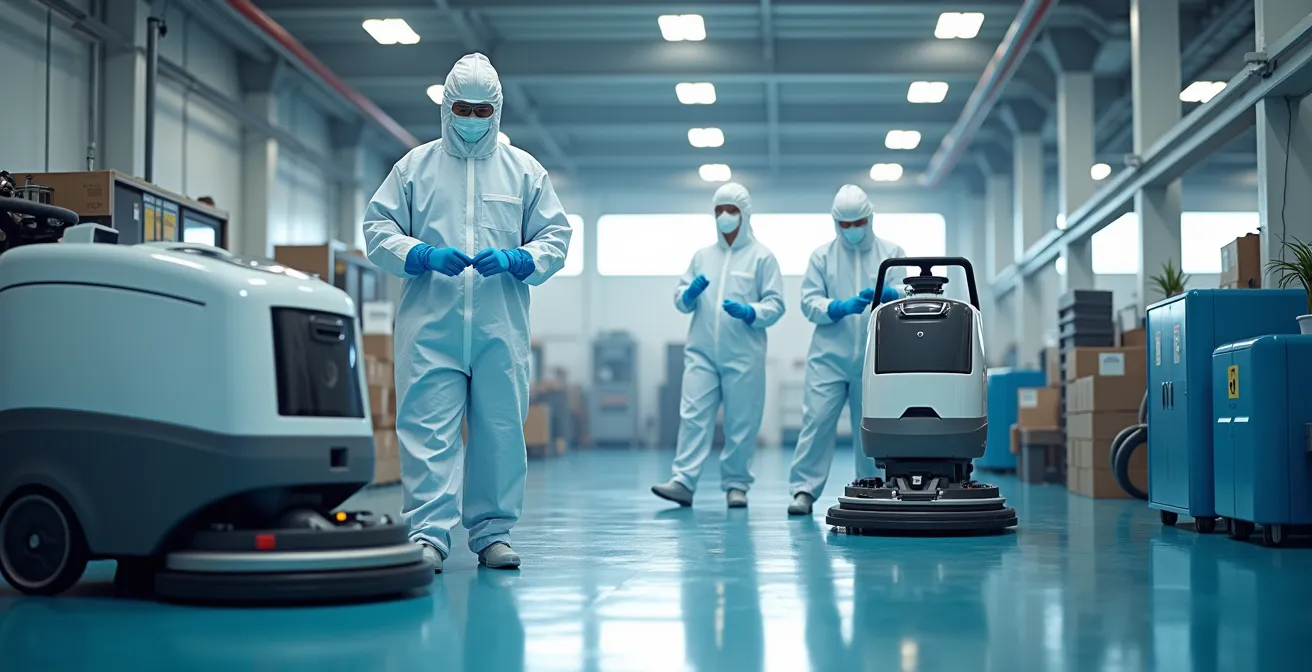
For many facility managers, industrial cleaning is often viewed through the narrow lens of regulatory compliance and basic aesthetics. While maintaining a visually tidy and hazard-free space is crucial, this perspective misses the profound strategic value that professional cleaning brings to an organization. True industrial hygiene transcends surface-level tidiness; it is a critical investment in your business’s core operational resilience, financial health, and human capital.
Failing to address the microscopic, legal, and systemic risks accumulating in an industrial environment is not merely a housekeeping oversight—it’s a strategic liability. Engaging with specialized partners for services like efsclean.com‘s professional industrial ceiling and wall cleaning is a proactive measure that safeguards assets, enhances productivity, and builds a culture of excellence. It’s time to reframe industrial cleaning not as a cost center, but as a foundational pillar of a high-performing, resilient, and safe enterprise.
Industrial Cleaning: Beyond the Surface
- Uncovers and neutralizes invisible microbial and airborne threats.
- Transforms compliance from a requirement into a strategic reputational asset.
- Delivers measurable ROI through enhanced operational efficiency and asset longevity.
- Directly boosts workforce productivity, morale, and safety.
Unveiling the invisible threats: The science behind industrial hygiene
Industrial environments are complex ecosystems where unseen threats can flourish. Beyond visible grime, surfaces and air can harbor microbial colonies, airborne contaminants, and allergens that pose significant long-term health risks to employees. The science of industrial hygiene focuses on identifying, evaluating, and controlling these hazards before they impact your workforce and operations.
What is industrial hygiene?
Industrial hygiene is the science dedicated to anticipating, recognizing, and controlling workplace conditions—such as chemical, physical, and biological hazards—that may cause injury, illness, or impair the well-being of employees.
Specific professional methods are designed to combat these microscopic threats with scientific precision. Advanced HEPA filtration systems capture airborne particles that standard filters miss, while electrostatic cleaning technology ensures that disinfectants wrap around and evenly coat complex machinery and surfaces. These specialized approaches are not just about cleaning; they are about systematically neutralizing pathogens and allergens at their source.
The consequences of neglecting this microbial landscape are quantifiable and severe. Chronic exposure to airborne dust, mold spores, or chemical residues can lead to respiratory illnesses, allergic reactions, and other long-term health issues, resulting in increased absenteeism, higher insurance premiums, and reduced employee morale. Proactive and scientific cleaning is the first line of defense.
Regular cleaning and disinfection significantly reduce hospital-acquired infections and antibiotic-resistant genes on surfaces.
– S Fijan et al., Frontiers in Microbiology
The application of advanced, science-backed cleaning protocols can yield dramatic results in controlling pathogens and ensuring a healthier environment for everyone.
Effectiveness of Probiotic-based Cleaning in Reducing Surface Pathogens
Hospital trials demonstrated a 90% reduction in contamination by Staphylococcus aureus and other pathogens through microbial-based cleaning, effectively lowering antibiotic resistance on surfaces.
Beyond compliance: Navigating the legal and reputational landscape of industrial cleanliness
Adhering to safety and cleanliness standards is the baseline, not the finish line. While compliance with bodies like OSHA is mandatory to avoid penalties, a proactive approach to industrial cleanliness serves as a powerful risk management tool and a significant driver of brand reputation. Neglecting these duties can lead to severe legal and financial repercussions far beyond a simple fine.
Inadequate cleaning can result in preventable accidents, such as slips from greasy floors or illnesses from poor air quality, opening the door to costly lawsuits, workers’ compensation claims, and soaring insurance premiums. Furthermore, properly maintaining a healthy work environment extends beyond floors to air systems, which can be a primary source of contaminants if not professionally serviced.

A pristine, well-maintained facility sends a powerful message to clients, partners, and employees. It communicates a commitment to quality, safety, and operational excellence, which directly enhances brand reputation and stakeholder confidence. A report on the financial impact of reputational damage in manufacturing highlights significant losses tied to non-compliance issues. This demonstrates that a clean facility isn’t an expense; it’s an investment in brand equity.
Non-compliance with cleaning regulations results in hefty fines, legal actions, and potential business closure.
– Summit Janitorial Compliance Insights, Summit Janitorial
Viewing professional cleaning services as a strategic partner in risk management allows a business to move beyond a reactive stance on compliance to a proactive strategy that protects against operational interruptions and builds lasting trust.
Legal and Compliance Failures at ABC Petrochemicals
ABC Petrochemicals incurred $10.7 million in fines and remediation costs due to improper hazardous waste disposal, which severely damaged their reputation and customer trust.
Maximizing operational resilience: The ROI of advanced industrial cleaning technologies
Investing in professional industrial cleaning is a direct investment in your facility’s operational uptime and resilience. The return on investment (ROI) is realized through reduced equipment downtime, longer asset lifespan, and lower overall maintenance costs. Modern cleaning is no longer just manual labor; it’s a technology-driven field aimed at maximizing efficiency.
What is the ROI of professional industrial cleaning?
The ROI of professional cleaning is measured in reduced equipment downtime, extended asset life, fewer workplace accidents, and improved employee productivity, all of which translate into direct cost savings and increased operational efficiency.
Emerging technologies are transforming the industry. Innovations like UV-C disinfection for sanitizing surfaces without chemicals, AI-driven monitoring systems to predict cleaning needs, and advanced air purification are becoming standard. The industrial cleaning equipment market, with a market valuation of USD 10.63 billion in 2024, is expanding rapidly to meet this demand for smarter, more effective solutions.
By integrating specialized cleaning into broader maintenance strategies, companies can prevent the buildup of corrosive agents, dust, and grime that lead to premature equipment failure. Clean machinery operates more efficiently, consumes less energy, and requires fewer costly repairs, directly enhancing facility resilience and protecting capital investments.
Impact of Robotic Cleaning in Manufacturing Facilities
A manufacturing plant achieved a 30% reduction in cleaning time using autonomous robotic cleaners, which improved overall workforce productivity and reduced downtime.
To effectively leverage these advancements, a strategic approach to technology integration is essential for maximizing your return.
Steps to Integrate Advanced Cleaning Technologies for Operational ROI
- Evaluate cleaning needs and identify suitable robotic solutions.
- Invest in staff training for maintenance and operation.
- Integrate cleaning schedules with facility management systems.
- Monitor cleaning performance and adjust protocols for efficiency.
Key Takeaways
- Industrial hygiene is a science that mitigates invisible health threats beyond surface-level cleaning.
- Proactive cleanliness serves as a powerful risk management tool, protecting brand reputation and avoiding legal issues.
- Advanced cleaning technologies deliver a strong ROI by enhancing equipment longevity and operational efficiency.
- A clean environment is directly linked to higher employee productivity, engagement, and talent retention.
The human element: Cultivating a high-performance workforce through superior environments
The physical state of a workplace is a direct reflection of an organization’s values and has a profound impact on its most valuable asset: its people. A clean, safe, and well-maintained environment is intrinsically linked to higher employee engagement, reduced stress, and improved talent retention. Studies show that employees work 7.5 minutes longer steadily in clean environments, demonstrating a clear link between cleanliness and focus.
Different industrial sectors require specialized cleaning protocols tailored to their unique operational needs. As Stanley Felderman notes in Kelly Industrial Services, even factors like light, which is improved by clean fixtures, can support focus and reduce fatigue. Testimonials from employees often reveal that cleaner workplaces lead to lower stress levels and fewer mental health days, fostering a culture of well-being and respect.
A demonstrable commitment to a superior environment signals that an organization values its employees’ health and safety above all else. This fosters a powerful culture of pride, respect, and mutual responsibility, which not only improves performance but also helps attract and retain top talent. Ultimately, a clean workplace can elevate the customer experience by ensuring that the products and services delivered are created in an environment of excellence.
Cleaning protocols for specialized industrial sectors
- Control dust in manufacturing areas to prevent respiratory issues.
- Manage allergens rigorously in food processing environments.
- Maintain sterility standards in pharmaceutical production zones.
- Train cleaning staff on sector-specific safety and hygiene standards.
Frequently Asked Questions on Industrial Cleaning Benefits
How often should an industrial facility be professionally cleaned?
The frequency depends on the industry, the type of work performed, and specific regulatory requirements. High-traffic areas or facilities handling hazardous materials may require daily cleaning, while other areas might need deep cleaning on a weekly, monthly, or quarterly basis. A professional assessment can determine the optimal schedule.
What’s the difference between standard commercial cleaning and industrial cleaning?
Industrial cleaning is far more specialized than commercial cleaning. It involves handling heavy machinery, hazardous materials, and complex environments that require specialized training, equipment, and adherence to strict safety regulations like those from OSHA. Commercial cleaning typically focuses on office spaces, retail, and other less hazardous settings.
Can professional cleaning really improve employee productivity?
Yes. Studies and workplace reports consistently show that employees in clean, organized environments are more focused, experience less stress, and take fewer sick days. A clean workspace reduces distractions and health hazards, directly contributing to improved morale and higher productivity.
Are new cleaning technologies like robots and UV-C disinfection worth the investment?
For many facilities, yes. These technologies offer significant returns by increasing efficiency, providing a more thorough and consistent level of clean, and reducing labor costs over time. They are particularly valuable in large-scale operations or environments requiring high levels of sanitation, where they can complete tasks faster and more effectively than manual methods.